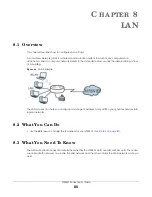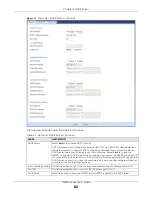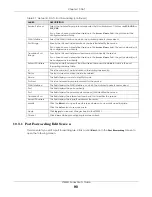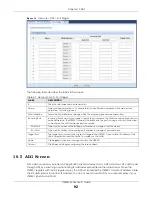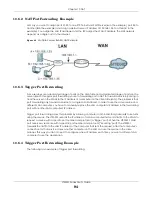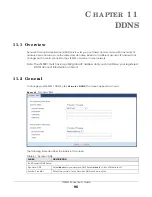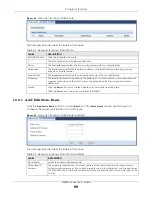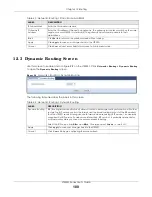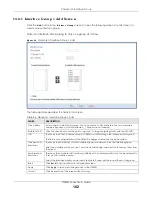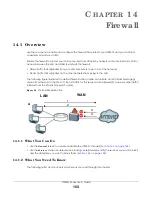
Chapter 10 NAT
LTE3301 Series User’s Guide
89
Note: Many residential broadband ISP accounts do not allow you to run any server processes
(such as a Web or FTP server) from your location. Your ISP may periodically check for
servers and may suspend your account if it discovers any active services at your
location. If you are unsure, refer to your ISP.
Port forwarding allows you to define the local servers to which the incoming services will be forwarded.
To change your LTE3301’s port forwarding settings, click
Ne two rk > NAT
>
Po rt Fo rwa rding
. The screen
appears as shown.
Note: If you do not assign a
De fa ult Se rve r
, the LTE3301 discards all packets received for ports
that are not specified in this screen or remote management.
Refer to
Appendix C on page 173
for port numbers commonly used for particular services.
Fig ure 56
Network > NAT > Port Forwarding
The following table describes the labels in this screen.
Table 37 Network > NAT > Port Forwarding
LABEL
DESC RIPTIO N
Default Server Setup
Default Server
In addition to the servers for specified services, NAT supports a default server. A default
server receives packets from ports that are not specified in the
Po rt Fo rwa rd ing
screen. You
can decide whether you want to use the default server or specify a server manually.
Select this to use the default server.
Change to Server
Select this and manually enter the server’s IP address.
Service Name
Select a pre-defined service from the drop-down list box. The pre-defined service port
number(s) and protocol will be displayed in the port forwarding summary table.
Otherwise, select
Use r de fine
to manually enter the service name and port number(s) and
select the IP protocol.
Содержание LTE3301 Series
Страница 10: ...10 PA RT I Use r s Guide...
Страница 40: ...Chapter 4 Tutorials LTE3301 Series User s Guide 40...
Страница 41: ...41 PA RT II T e c hnic al Re fe re nc e...






